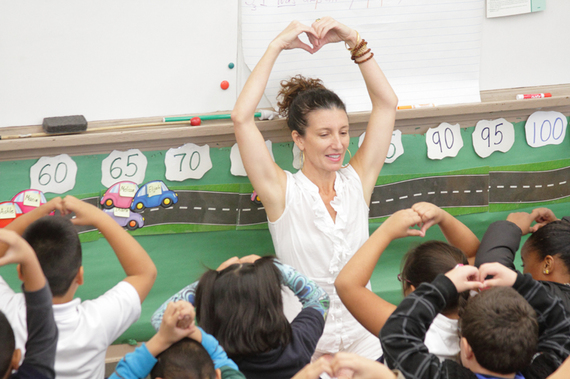This is an interview with Kelly Wood, who opened Karuna Yoga studio in Los Angeles in 2002. Since the opening of the studio, she has taught kids yoga classes with consistent attendance. Parents who were taking her adult yoga classes asked if she would consider going into their child's public school classroom to teach kids yoga. In 2002, she began teaching weekly 20-minute classes in LAUSD elementary schools, continuing to this day with a strong network of public school teachers, principals, school therapists, administrators, and parents. She has now taught over 220,000 students from Pre-K to 5th grade. According to Kelly, "once children are in a more calm state, they can remember or be more mindful of actions, thoughts, and words from the heart -- a more helpful behavior as opposed to self-centeredness."
Rob: What originally motivated you to do this work, and what continues to motivate you? How, if at all, has that motivation changed over time?
Kelly: My initial motivation was to help children develop a love for, and commitment to, the practice. Now I'm motivated to assist with the integration of positive habits such as listening, patience, and helping others within the behavior of children. I believe in the potential of every child. I understand how emotional experiences shape our neural networks--the way we think.
Within public classrooms my motivation is also to build a sense of respect in students for their public school teacher. I am dedicated to helping teachers who give so much to their students, communities, and schools. Our SCHOOL (Smiling Calm Hearts Open Our Learning) classes nurture respect and emotional security within classrooms.
Is there a standout moment from your work with elementary school children?
A gratifying moment is when I hear of or see a student applying teachings without my impetus. It is also gratifying to see the gradual conditioning of students' learning within our SCHOOL classes. Once children learn the rules and boundaries of the SCHOOL classes, which typically takes four sessions, we have more classroom moments of taking a calm breath in and a calm breath out together. To see an entire classroom take a simultaneous calm breath in and out is very rewarding for me. I'm fortunate to sit in front of children and witness their development of self-regulation and more gentle attitudes, one breath at a time.
What did you know about the population you are working with before you began teaching? What were some of the assumptions you had about this population, and how have those assumptions changed?
More than 80 percent of the children I teach are Hispanic, with the remaining 20 percent mostly other minorities. Growing up in South Carolina and living in the south until my early 30s, I had little to no interaction with the Hispanic culture. I assumed these children would know Spanish better than I. This proved to be true! Other than this obvious fact, I truly was and remain open to each classroom. I only need to simplify English words of instruction for the Pre-K classes to better communicate the yoga lessons. Because children are strong visual learners, they pick up the lessons quickly as I exhibit posture, pace, and facial expressions. I find inner-city children quite open and eager to learn yoga/meditation.
What are two distinct ways that your teaching style differs from the way you might teach in a studio, and what are the reasons for these differences?
The first difference in teaching style is the acknowledgement that I'm a guest within the public school teacher's classroom. I defer to the classroom teacher for acceptable choices for addressing disruption (talking, distracting peers). I ask for permission to show an image to reinforce the story told at the beginning of class, or if I may move a chair or easel to make more space. SCHOOL kids yoga classes always point to the leadership of the public school teacher. I may refer to the teacher as very patient with students, if the story told at the top of a SCHOOL class highlights developing patience. SCHOOL kids yoga classes often include students making a heart with their hands and sharing their calm heart with their public school teacher. I make myself insignificant, always emphasizing the positive qualities of the public school teacher.
A second way my teaching style differs within public classrooms is that the theme or teaching of each SCHOOL kids yoga class is specifically tailored to the activities, skills, and behavior of daily school life. For example, I may tell a story about being very hungry after a full morning of teaching, and sharing my lunch with a stranger who needed food. Once we've established that it is good to be generous, and that being calm helps us give to others, I would then ask the students to think of ways they can be generous and give to their classmates and their teacher in their classroom. Our movements, postures, and meditations would also include positive affirmations about giving.
What is the role of humor in your practice, in your classes?
Humor makes its way into SCHOOL classes effortlessly from children's comments, suggestions, and questions. I do not put on a show with children, or intentionally try to be funny. Simplicity and honesty make for an uplifting tone, especially as these children take the practice seriously and relate easily to the idea of using their calm breathing to keep a calm heart.
What has been the greatest challenge in your teaching experience, and what tools have you developed for addressing that challenge?
The greatest challenge has been bringing the public up to speed on the fact that proper yoga/meditation practice is more than creating healthier and calmer bodies. Yoga/meditation practice must build caring and helpful dispositions that are evident within behavior. SCHOOL root teachings (patience, generosity, etc.) integrated within movement contribute to mindfulness and self-regulation. SCHOOL classes are quite simple, with emphasis on calm breathing and a calm heart to help build habits of positively adapting to people and life. Busyness, distraction, complaining, and emotionality can be re-patterned when one is more centered and calm. Children who are unable to self-regulate beyond a negative emotion have a more difficult time adapting, learning, and relating positively to others. It is of little use to our community if we produce high test scoring students with the absence of caring hearts. I believe our schools are the places to teach basic life skills that are secular and common to being good people.
What advice would you give to anyone who is going to teach in the population you work with?
Never look at these children as less than yourself. Quite the contrary, look at these children as your teachers, helping you to grow. Exhibit and live the qualities you know they also have within themselves that are helpful for their classrooms, homes, and communities. There may just be a time in the future when you will lean on the kindness and compassion of these children as they are adults and you are in your senior years.
What are some of your ideas about or hopes for the future of "service yoga" in America in the next decade?
If those teaching yoga in service to the community have a comprehensive understanding and approach to the practice (not an emphasis on physicality), we may be able to further innovate health and healing in America, while sustaining respect for the origins and purpose of the practice.
Editor: Alice Trembour
Images: Courtesy of Josh Wood Photography
Stay connected with Give Back Yoga Foundation as we share the gift of yoga with the world, one person at a time, by following us on Facebook, Twitter and Google+ and by subscribing to our newsletter.
Are you a yoga instructor giving back to underserved populations? E-mail Executive Director Rob Schware if you're interested in being interviewed for this series.

